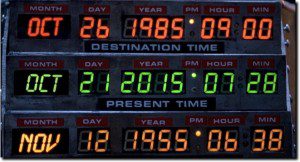 I just returned from 10 enjoyable days with family and friends in three U.S. cities (1). I’m still amazed at how the smartphone has made traveling so much easier. Text messaging (especially with speech-to-text), Google maps, Yelp, Uber, Expedia, Alaska Airlines, Siri and more. If only the battery would hold out all day, it would be nearly perfect.
I just returned from 10 enjoyable days with family and friends in three U.S. cities (1). I’m still amazed at how the smartphone has made traveling so much easier. Text messaging (especially with speech-to-text), Google maps, Yelp, Uber, Expedia, Alaska Airlines, Siri and more. If only the battery would hold out all day, it would be nearly perfect.
But one area that still lags is personal finance. Sure, you can get your bank balance or transfer cash on your phone 24/7, but I could do that in 1985 through an 800-number. Where’s the Back to the Future stuff?
It will be here sooner than you think.
Had the worldwide financial system not teetered on the brink less than seven years ago, we’d have all kinds of financial hover boards and self-lacing shoes. But there were a few other projects that had priority, like righting the ship.
But with that mostly behind us, we should see real progress in the next few years. Here are five Bank to the Future predictions for 2020 (or sooner). The basic technology for each is already available and has been on stage at Finovate and/or FinDEVr:
- Financial travel guard: Automatically alerts card issuers and banks to your exact location, which is fed into authorization algorithms to ensure approvals wherever you go. And tokenization masks your card numbers from dishonest or careless shopkeepers.
- Annotated spending storybook: Sure, you can look back at your pictures from four years ago to help remember the name of that ice cream shop you visited. But with spending location, annotations (including your photos or receipts) and extensions (such as Yelp integration), your “story” as told through transactions is readily accessible in a searchable database accessed with a few keystrokes or voice commands. Of course, there’s a map view, too.
- Family integration: Adding family members to your account should be like connecting on social media, not going through an FBI background check. We’ll need some support from the regulators, but we’ll get there eventually. And once connected, it should be easy to share funds, co-sign loans, manage savings and get everyone’s finances in sync like Dropbox, Evernote or iCloud (although that last one perhaps shouldn’t be the model).
- No. More. Passwords: Username/password authentication is a pesky holdover from the 1980s. Biometrics and device identification will rule very soon.
- Real-time insurance: Granted, this will take longer than five years, but the future will have on-demand insurance. Like calling on Uber, if you decide you want a little extra protection for your car, for your business, for the guests at your party, you just select the right button, turn the dial, and order it up. Pricing will be transparent and real-time. There may be “surge fare” premiums, but that’s part of the on-demand model.
Check back with me in 21 Oct 2020, and we’ll see if I did as well as the movie.
——-
(1) Which explains why my Back to the Future-themed post is running a week after the official 21 Oct date.
